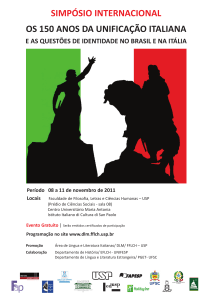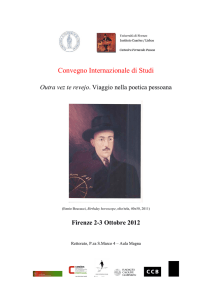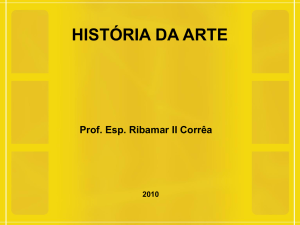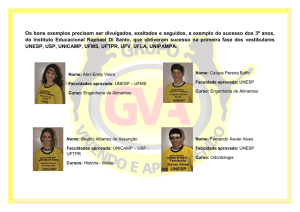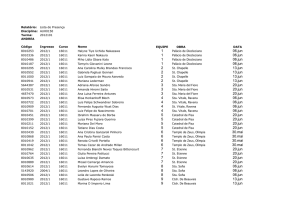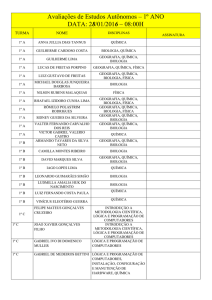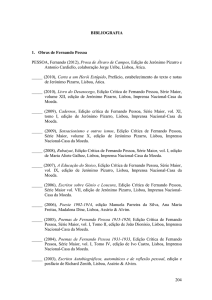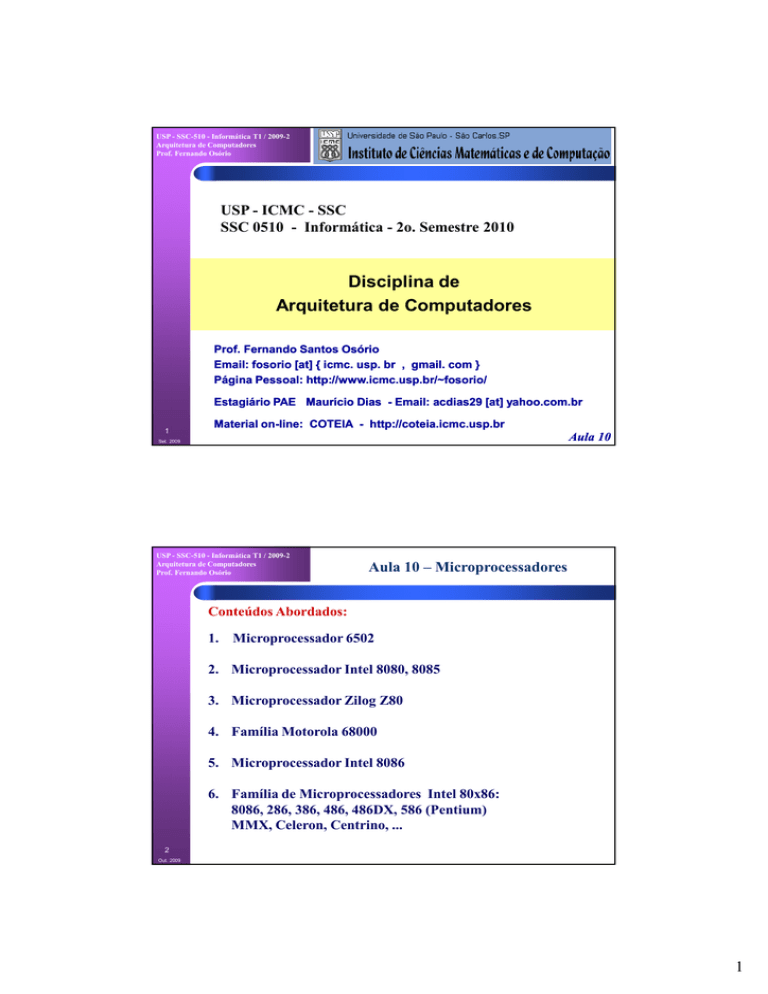
USP - SSC-510 - Informática T1 / 2009-2
Arquitetura de Computadores
Prof. Fernando Osório
USP - ICMC - SSC
SSC 0510 - Informática - 2o. Semestre 2010
Disciplina de
Arquitetura de Computadores
Prof. Fernando Santos Osório
Email: fosorio [at] { icmc
icmc.. usp.
usp. br , gmail.
gmail. com }
Página Pessoal:
Pessoal: http://www.icmc.usp.br/~fosorio/
Estagiário PAE Maurício Dias - Email: acdias29 [at] yahoo.com.br
1
Material onon-line: COTEIA - http://coteia.icmc.usp.br
Aula 10
Set. 2009
USP - SSC-510 - Informática T1 / 2009-2
Arquitetura de Computadores
Prof. Fernando Osório
Aula 10 – Microprocessadores
Conteúdos Abordados:
1. Microprocessador 6502
2. Microprocessador Intel 8080, 8085
3. Microprocessador Zilog Z80
4. Família Motorola 68000
5. Microprocessador Intel 8086
6. Família de Microprocessadores Intel 80x86:
8086, 286, 386, 486, 486DX, 586 (Pentium)
MMX, Celeron, Centrino, ...
2
Out. 2009
1
USP - SSC-510 - Informática T1 / 2009-2
Arquitetura de Computadores
Prof. Fernando Osório
1. Microprocessador 6502
Arquitetura 6502
Microprocessador de 8 bits dados e 16 bits de endereço
N
V
B
D
I
Z
C
3
Out. 2009
-
Negative Flag
Overflow Flag
Break Command
Decimal Mode
Int. Disable
Zero Flag
Carry Flag
* Refs:
Leventhal, Lance A. (1986). 6502 Assembly Language Programming 2nd Edition. Osborne/McGraw-Hill.
Leventhal, Lance A. (1982). 6502 Assembly Language Subroutines. Osborne/McGraw-Hill. ISBN 0931988594.
USP - SSC-510 - Informática T1 / 2009-2
Arquitetura de Computadores
Prof. Fernando Osório
Microprocessador
6502
4
Out. 2009
2
USP - SSC-510 - Informática T1 / 2009-2
Arquitetura de Computadores
Prof. Fernando Osório
2. Microprocessador Intel 8080
Arquitetura Intel 8080
Microprocessador: [1974]
8/16 bits dados
16 bits de endereço
5
Out. 2009
USP - SSC-510 - Informática T1 / 2009-2
Arquitetura de Computadores
Prof. Fernando Osório
2. Microprocessador Intel 8080
Arquitetura Intel 8080
6
Microprocessador: [1974]
8/16 bits dados
16 bits de endereço
Out. 2009
3
USP - SSC-510 - Informática T1 / 2009-2
Arquitetura de Computadores
Prof. Fernando Osório
2. Microprocessador Intel 8080 / 8085
Arquitetura Intel 8080 / 8085
7
CPU Registers
Microprocessador de 8/16 bits dados e 16 bits de endereço
Out. 2009
USP - SSC-510 - Informática T1 / 2009-2
Arquitetura de Computadores
Prof. Fernando Osório
2. Microprocessador Intel 8080 / 8085
Arquitetura Intel 8080 / 8085
CPU Registers
“From a software point of view there is only a small difference
between the 8080 and 8085. In fact the main difference is that
the 8085 has 2 extra instructions to deal with its serial input and
serial output pins and interrupt system.
Apart from that the 8085 uses less cycles to complete
its instructions, making it faster than the 8080.
The hardware differences between the two processors
are more spectacular. You'd better use a 8085 if you plan
to use either of the 2 processors because it is much easier
to interface with.”
http://www.sbprojects.com/sbasm/8080.htm
8
Microprocessador de 8/16 bits dados e 16 bits de endereço
Out. 2009
4
USP - SSC-510 - Informática T1 / 2009-2
Arquitetura de Computadores
Prof. Fernando Osório
3. Microprocessador Z80
Arquitetura Zilog Z80
O Z80 foi desenvolvido para ser um
substituto do 8080 com algumas
Vantagens...
Microprocessador: [1976]
8/16 bits dados
16 bits de endereço
9
Out. 2009
USP - SSC-510 - Informática T1 / 2009-2
Arquitetura de Computadores
Prof. Fernando Osório
3. Microprocessador Z80
Arquitetura Zilog Z80
10
Out. 2009
5
USP - SSC-510 - Informática T1 / 2009-2
Arquitetura de Computadores
Prof. Fernando Osório
3. Microprocessador Z80
Arquitetura Zilog Z80
Alternative Registers Set
Main Registers Set
Accumulator
Flags
Accumulator
Flags
A
F
A’
F’
B
C
B’
C’
D
E
D’
E’
H
L
H’
L’
Interrupt Vector
I
11
CPU Registers
General
Purpose
Registers
Memory Refresh
R
Index Register
IX
Index Register
IY
Stack Pointer
SP
Program Counter
PC
Special Purpose
Registers
Out. 2009
USP - SSC-510 - Informática T1 / 2009-2
Arquitetura de Computadores
Prof. Fernando Osório
3. Microprocessador Z80
Arquitetura Zilog Z80
CPU Registers
8080 / 8085
X
Z80
12
Out. 2009
6
USP - SSC-510 - Informática T1 / 2009-2
Arquitetura de Computadores
Prof. Fernando Osório
3. Microprocessador Z80
Arquitetura Zilog Z80
The 8080 compatible registers:
AF - 8-bit accumulator (A) and flag bits (F)
Flags: Carry, Zero, Minus, Parity/overflow, Half-carry (used for BCD),
and an Add/Subtract flag (usually called N) also for BCD
BC - 16-bit data/address register or two 8-bit registers
DE - 16-bit data/address register or two 8-bit registers
HL - 16-bit accumulator/address register or two 8-bit registers
SP - stack pointer, 16 bits
PC - program counter, 16 bits
Registers introduced with the Z80:
13
IX - 16-bit index or base register for 8-bit immediate offsets
IY - 16-bit index or base register for 8-bit immediate offsets
I - interrupt vector base register, 8 bits
R - DRAM refresh counter, 8 bits (MSB does not count)
AF' - alternate (or shadow) accumulator and flags (toggled in and out with EX AF,AF' )
BC',DE', and HL' - alternate (or shadow) registers (toggled in and out with EXX)
Four bits of interrupt status and interrupt mode status
Out. 2009
USP - SSC-510 - Informática T1 / 2009-2
Arquitetura de Computadores
Prof. Fernando Osório
3. Microprocessador Z80
Arquitetura Zilog Z80
14
Out. 2009
7
USP - SSC-510 - Informática T1 / 2009-2
Arquitetura de Computadores
Prof. Fernando Osório
4. Microprocessador Motorola 68000
Família Motorola 68000
M
[1979]
15
Out. 2009
USP - SSC-510 - Informática T1 / 2009-2
Arquitetura de Computadores
Prof. Fernando Osório
4. Microprocessador Motorola 68000
Arquitetura
Motorola 68000
16
Out. 2009
8
USP - SSC-510 - Informática T1 / 2009-2
Arquitetura de Computadores
Prof. Fernando Osório
4. Microprocessador Motorola 68000
Arquitetura
Motorola 68000
17
Out. 2009
USP - SSC-510 - Informática T1 / 2009-2
Arquitetura de Computadores
Prof. Fernando Osório
4. Microprocessador Motorola 68000
Arquitetura
Motorola 68000
The M68000 family programming model consists of two register groups:
User and Supervisor.
User programs executing in the user mode only use the registers in the user group.
System software executing in the supervisor mode can access all registers and
uses the control registers in the supervisor group to perform supervisor functions.
System programers use the supervisor programming model to implement sensitive
operating system functions—e.g., I/O control and memory management unit (MMU)
subsystems. There are registers accessible only in the supervisor programming mode.
They can only be accessed via privileged instructions.
18
Out. 2009
9
USP - SSC-510 - Informática T1 / 2009-2
Arquitetura de Computadores
Prof. Fernando Osório
4. Microprocessador Motorola 68000
Arquitetura
Motorola 68000
19
Out. 2009
USP - SSC-510 - Informática T1 / 2009-2
Arquitetura de Computadores
Prof. Fernando Osório
4. Microprocessador Motorola 68000
Arquitetura
Motorola 68K
FPU
20
Out. 2009
10
USP - SSC-510 - Informática T1 / 2009-2
Arquitetura de Computadores
Prof. Fernando Osório
4. Microprocessador Motorola 68000
Arquitetura
Motorola 68K
FPU
21
Out. 2009
USP - SSC-510 - Informática T1 / 2009-2
Arquitetura de Computadores
Prof. Fernando Osório
4. Microprocessador Motorola 68000
Arquiteturas do 4004 ao 68000
22
Out. 2009
Web: http://www.redhill.net.au/c/c-1.html
11
USP - SSC-510 - Informática T1 / 2009-2
Arquitetura de Computadores
Prof. Fernando Osório
4. Microprocessador Motorola 68000
Arquiteturas do 4004 ao 68000
http://en.wikipedia.org/wiki/MOS_Technology_6502
The MOS Technology 6502 is an 8-bit microprocessor that was designed by Chuck Peddle and
Bill Mensch for MOS Technology in 1975. When it was introduced, it was the least expensive
full-featured microprocessor on the market by a considerable margin, costing less than one-sixth
the price of competing designs from larger companies such as Motorola and Intel. The 6502 is an
8-bit processor with a 16-bit address bus.
The 6502 was designed primarily by the same engineering team that had designed the Motorola
6800. After resigning from Motorola en masse, the team went looking for another company that
would be interested in hosting a design team, and found MOS Technology, then a small
chipmaking company whose main product was a single-chip implementation of the popular Pong
video game.
23
Out. 2009
Clock: 1Mz (6502) 2Mz (6502A) 3Mhz (6502B)
Pins: 40-pin DIP
Data Bus: 8 bits
Address Bus: 16 bits (64Kb addressable memory)
Manufacturer: MOS Tech – Year: 1975
USP - SSC-510 - Informática T1 / 2009-2
Arquitetura de Computadores
Prof. Fernando Osório
4. Microprocessador Motorola 68000
Arquiteturas do 4004 ao 68000
Microprocessador de 8/16 bits dados e 16 bits de endereço
http://www.redhill.net.au/c/c-1.html
http://en.wikipedia.org/wiki/Intel_8080
24
Clock: 2Mz / 3Mhz
The processor had seven 8-bit registers, (A, B, C, D, E, H, and L)
Pins: 40-pin DIP
Register A: 8-bit accumulator, 16-bit register in pairs (BC, DE, HL)
Data Bus: 8 bits
The address bus had its own 16 pins, and the data bus had 8 pins
Address Bus: 16 bits
(64Kb addressable memory)
Manufacturer: Intel – Year: 1974
Out. 2009
12
USP - SSC-510 - Informática T1 / 2009-2
Arquitetura de Computadores
Prof. Fernando Osório
4. Microprocessador Motorola 68000
25
Out. 2009
USP - SSC-510 - Informática T1 / 2009-2
Arquitetura de Computadores
Prof. Fernando Osório
4. Microprocessador Motorola 68000
26
Out. 2009
13
USP - SSC-510 - Informática T1 / 2009-2
Arquitetura de Computadores
Prof. Fernando Osório
5. Microprocessador Intel 8086
Arquiteturas do Intel 8086 / 8088
Microprocessador: [1978]
16 bits dados
20 bits de endereço
4,77 MHz
27
Out. 2009
USP - SSC-510 - Informática T1 / 2009-2
Arquitetura de Computadores
Prof. Fernando Osório
5. Microprocessador Intel 8086
Arquiteturas do Intel 8086 / 8088
Microprocessador: [1978]
8/16 bits dados
20 bits de endereço
4,77 MHz
8086 - primeiro microprocessador
de 16 bits da Intel
– Arquitetura de 16 bits
28
Out. 2009
–
Comunicação com a memória em 16 bits (8086)
Capacidade máxima de memória de 1 MByte
Registradores: 14 regs.
4 regs. dado, 4 regs. endereço,
4 regs. segmento, reg. ponteiro do programa, reg. flags
Endereço físico = segmento * 16 + deslocamento (!)
Instruções básicas: 85
Co-processador: 8087 (67 instruções básicas)
Sem cache, sem memória virtual
8088: Mesma arquitetura, barramento externo de 8 bits
14
USP - SSC-510 - Informática T1 / 2009-2
Arquitetura de Computadores
Prof. Fernando Osório
5. Microprocessador Intel 8086
Arquiteturas
Intel 8086 / 8088
AH, AL: 8 bits
AX: AH + AL = 16 bits
CS: Code Segment = 16 bits
IP : Instruction Pointer = 16 bits
Program Counter: CS + IP
16 bits / 16 bits => 20 bits
CS
16-bit Segnment Base Address
0000
IP
16-bit Offset Address
29
20-bit Physical Address
Out. 2009
USP - SSC-510 - Informática T1 / 2009-2
Arquitetura de Computadores
Prof. Fernando Osório
5. Microprocessador Intel 8086
Arquiteturas
Intel 8086 / 8088
30
Out. 2009
15
USP - SSC-510 - Informática T1 / 2009-2
Arquitetura de Computadores
Prof. Fernando Osório
5. Microprocessador Intel 8086
Arquiteturas Intel 8086 / 8088
31
Out. 2009
USP - SSC-510 - Informática T1 / 2009-2
Arquitetura de Computadores
Prof. Fernando Osório
5. Microprocessador Intel 8086
Arquiteturas Intel 8086 / 8088
AX - Accumulator
BX - Base Register
CX - Count Register
DX - Data Register
IP - Instruction Pointer
CS - Code Segment Register
DS - Data Segment Register
SS - Stack Segment Register
ES - Extra Segment Register
SP - Stack Pointer
BP - Base Pointer
SI - Source Index Register
DI - Destination Register
32
Out. 2009
16
USP - SSC-510 - Informática T1 / 2009-2
Arquitetura de Computadores
Prof. Fernando Osório
5. Microprocessador Intel 8086
Arquiteturas Intel 8086 / 8088
AX - Accumulator
BX - Base Register
CX - Count Register
DX - Data Register
SP - Stack Pointer
BP - Base Pointer
SI - Source Index Register
DI - Destination Register
IP - Instruction Pointer
CS - Code Segment Register
DS - Data Segment Register
SS - Stack Segment Register
ES - Extra Segment Register
FLAGs:
Bit 0 - CF Carry Flag - Set by carry out of msb
Bit 2 - PF Parity Flag - Set if result has even parity
Bit 4 - AF Auxiliary Flag - for BCD arithmetic
Bit 6 - ZF Zero Flag - Set if result is zero
Bit 7 - SF Sign Flag = msb of result
Bit 8 - TF Single Step Trap Flag
Bit 9 - IF Interrupt Enable Flag
Bit 10 - DF String Instruction Direction Flag
Bit 11 - OF Overflow Flag
Bits 1, 3, 5, 12-15 are undefined.
33
Out. 2009
USP - SSC-510 - Informática T1 / 2009-2
Arquitetura de Computadores
Prof. Fernando Osório
5. Microprocessador Intel 8086
34
Out. 2009
17
USP - SSC-510 - Informática T1 / 2009-2
Arquitetura de Computadores
Prof. Fernando Osório
5. Microprocessador Intel 8086
35
Out. 2009
USP - SSC-510 - Informática T1 / 2009-2
Arquitetura de Computadores
Prof. Fernando Osório
6. Microprocessadores x86
Família Intel 8086: x86
80186, 80286, 386, 486, 486SX/DX, Pentium (MMX, II, III, Pro, Xeon, P4)
Intel Celeron, Intel Centrino, ...
36
Out. 2009
* Ref.: Weber, Raul – Inf112 / Livro: Arquitetura de Computadores Pessoais. Bookman, 2008.
18
USP - SSC-510 - Informática T1 / 2009-2
Arquitetura de Computadores
Prof. Fernando Osório
6. Microprocessadores x86
Família Intel 8086: x86
Do Pentium ao Pentium II
37
Out. 2009
* Ref.: Weber, Raul – Inf112 / Livro: Arquitetura de Computadores Pessoais. Bookman, 2008.
USP - SSC-510 - Informática T1 / 2009-2
Arquitetura de Computadores
Prof. Fernando Osório
6. Microprocessadores x86
Família Intel 8086: x86
38
Out. 2009
* Ref.: Weber, Raul – Inf112 / Livro: Arquitetura de Computadores Pessoais. Bookman, 2008.
19
USP - SSC-510 - Informática T1 / 2009-2
Arquitetura de Computadores
Prof. Fernando Osório
6. Microprocessadores x86
Família Intel 8086: x86
39
Out. 2009
* Ref.: Weber, Raul – Inf112 / Livro: Arquitetura de Computadores Pessoais. Bookman, 2008.
USP - SSC-510 - Informática T1 / 2009-2
Arquitetura de Computadores
Prof. Fernando Osório
6. Microprocessadores x86
Família Intel 8086: x86
40
Out. 2009
* Ref.: Weber, Raul – Inf112 / Livro: Arquitetura de Computadores Pessoais. Bookman, 2008.
20
USP - SSC-510 - Informática T1 / 2009-2
Arquitetura de Computadores
Prof. Fernando Osório
INFORMAÇÕES SOBRE A DISCIPLINA
USP - Universidade de São Paulo - São Carlos, SP
ICMC - Instituto de Ciências Matemáticas e de Computação
SSC - Departamento de Sistemas de Computação
Prof. Fernando Santos OSÓRIO
Web institucional: http://www.icmc.usp.br/ssc/
Página pessoal: http://www.icmc.usp.br/~fosorio/
E-mail
mail:: fosorio [at]
at] icmc.
icmc. usp.
usp. br ou fosorio [at]
at] gmail.
gmail. com
Disciplina de Arquitetura de Computadores / Informática
Estagiário PAE: Maurício A. Dias
Web disciplina: COTEIA - Http://coteia.icmc.usp.br
> Programa, Material de Aulas, Critérios de Avaliação,
> Lista de Exercícios, Trabalhos Práticos, Datas das Provas
41
Set. 2009
Visite regularmente o site da CoTeia - Material em permanente atualização
21

